CORD Fundamentals with OpenStack
CORD Represents a Philosophical Change
Cloud computing and cloud centers dominate the data industries biggest architectures. Corporations such as Google, Facebook, Apple, Amazon and others have pioneered and honed these technologies to minimize costs whilst maximizing user performance and network agility. However, the providers of the networks that institutions, businesses, and homes use to access these clouds (and all forms of Internet access) have traditionally been constrained by the use of multiple vendor proprietary equipment to deliver these services. Vendor gear utilized for both customer premise and provider’s edge data office generally has all the control, feature and service software residing directly on the devices. This type of gear has always been limited by high capital and operational costs combined with limited scalability and upgradeability. For example, a provider who uses access gear from vendor A may want to introduce a new feature heavily desired by customers and only available from vendor B. The provider needs to either wait for vendor A to provide an upgrade, if possible, or replace the access gear entirely. Both are time consuming, costly and sometimes a risky venture as network churn usually succumbs to technical and financial consequences.
CORD (Central Office Re-architected as a Data center) is an open source project that undertakes to take the advantages of cloud technologies and apply them so that the fundamental access network architecture becomes virtualized in an agile and economic cloud environment. Traditional windowless Telco edge offices are being transformed into the cloud access data centers defined by CORD. Using a cloud environment at the edge offices provides elastic advantages of scalability, modularity and programmability. In addition, this elasticity enables providers to expeditiously introduce new revenue streams while at the same time delighting their customers with new technologies that can be added with little risk and considerably less expenditure.
So, what is CORD and how does it work to replace the existing access network? – the rest of this Technology Brief endeavors to delve into answering that question and is intended to familiarize the reader with a basic working knowledge of CORD.
CORD Open Hardware
One of CORDs principles is the use of open appliance hardware that leverages merchant silicon. Recently, manufacturers have been producing open hardware, sometimes referred to as “bare-metal” devices, in categories including servers, switches, and now edge devices such as OLTs. These type of devices have been labelled as hardware commodities on which the cloud can reside or utilize to perform the work of moving data. Having hardware as a commodity results in a market where a network provider can source the hardware from any open hardware vendor. No longer constrained to use a single vendors gear equates to remarkable advantages of economy and efficiency in procurement.
Some examples of open hardware include:
This type of equipment is delivered without any software except for a bootloader. The bootloader allows CORD to install the applicable OS, hardware abstraction software for merchant silicon (usually Broadcom ASICs) and services to fulfill the role of the CORD node.
Physical Hardware – CORD PODs
A POD in CORD terms is the physical collection of the network appliances that underpin a virtualized delivery platform. The term POD derives from “Point of Delivery” which is exactly what CORD aims for as an edge office architecture. A basic or full POD is defined by CORD to consist of a Top-of-Rack management switch, four fabric switches, and three x86 servers.
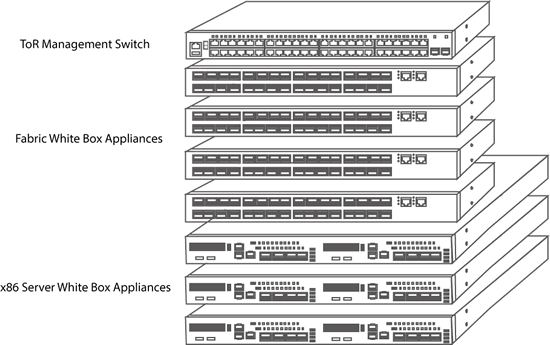
In addition, a CORD POD will also have open access equipment to serve customer premises and/or aggregation needs to provide a physical and logical data path to the CORD cloud and a customer’s virtual services. Depending on capacity or service expansion requirements, an operator needs just procure additional open hardware as additional switching or compute resources demand dictates. CORD services are designed to operate in cluster mode across multiple hardware nodes and also as instantiations of services as needed on a designated available node.
The CORD Data Plane
In CORD, the open switch fabric nodes are interconnected in a spine and leaf configuration and the access nodes, x86 servers, and metro network (Internet) are provisioned with links to the POD leaf switches.
The x86 servers are divided up as follows.
- Head Node 1 – providing the orchestration, control and provisioning services
- Compute Node 1 – assignable compute services for virtual services
- Compute Node 2 – assignable compute services for virtual services
- Additional commodity servers for both Head and Compute nodes can be added as customers, traffic, and services expand.
The CORD user plane from a customer device to an upstream network, generally traverses the POD as follows:
- Customer to Access Device – open CPE equipment – Fiber/RF/Ethernet medium towards an open aggregation device e.g. R-CORD vOLT.
- Aggregation Device to Compute Node – From the access or aggregation node the customer’s data flows via the fabric network to the compute nodes, which harbor the instantiated virtual services that manage the customer’s data stream.
Compute Node towards the Upstream Network – by way of a virtual router instantiation also existing within a POD compute node utilizing the leaf and spine fabric to provide the data path between compute nodes (if necessary) and the upstream network.
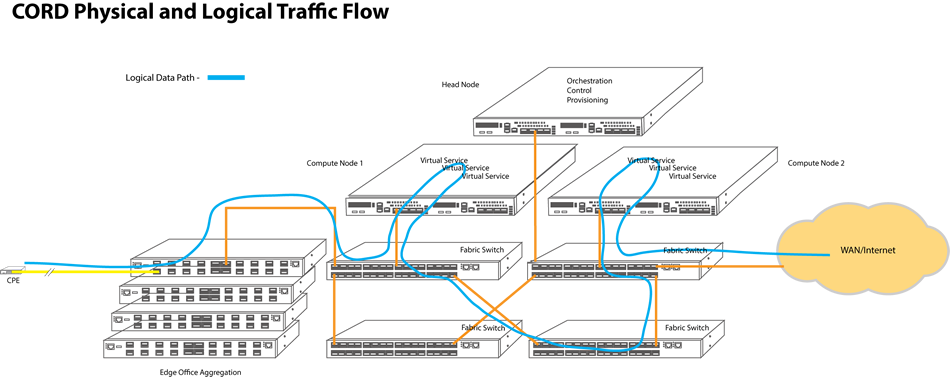
Control and Management in CORD Infrastructure
In the CORD system, network control and configuration management is centralized on the head node. It has multiple functions such as for example, data flow control and service virtualization. To perform this, the head node runs multiple CORD applications utilizing OpenStack as the cloud framework. A few of the main management services as discussed in this brief are:
- XOS (Everything as a Service) for orchestration using data model input
- ONOS (Open Networks OS) for network and flow control
- and MAAS (Metal as a Service) for provisioning of open network appliances
All other nodes in CORD receive their software from the Head node as they are commissioned through additions to CORD’s data model. Further, as customer services, open CPEs, and commodity equipment is added dynamically or statically to a CORD POD, the head node creates their abstracted virtualized entities required within the compute node resources available.
The Open Switch Facilitator
Multiple vendors providing commodity equipment requires a facilitator to ensure that open hardware from vendor A can be integrated equally well as one from Vendor B. Besides having compatible commodity hardware, an important development from the open source community is a project known as ONIE or Open Network Installer Environment (an Open Compute Project). ONIE is a scaled-down version of Linux installed on open hardware. Its purpose is to ease the secure installation of the operating system that the appliance will utilize. Switch operating systems sourced from vendors, or from open source projects such as ONL (Open Network Linux), can be produced to be compatible with ONIE. This opens the way for large scale automated OS provisioning. An operator can purchase open switch hardware from their supplier of choice (a CAPEX advantage) and integrate it into a CORD network. They can then realize OPEX gains from automation of a single installation environment platform. (MAAS, as will be discussed later.)
How CORD Uses OpenStack for Cloud Functionality
Understanding the operation of OpenStack is worthwhile when dealing with the functions of cloud computing and how OpenStack enables it. OpenStack provides the functionality that can deliver cloud services, including compute services, storage services, and network services. A tenant (a user or service whose data is isolated from others) needs to access these cloud services, and OpenStack implements this by acting as the orchestrator and framework for the cloud. OpenStack is made up of a collection of open source software projects that CORD uses to “cloudify” the edge office. Most projects in OpenStack act “as a Service” and the table below lists some of these projects along with a brief description.
| Project | Service | As a Service |
|---|---|---|
| Nova | Provides a method to create computer services such as virtual machines, bare metal servers and some container services. | Compute as a Service |
| Swift | Provides Object Storage – Generally for large static storage needs that do not need to be updated i.e. web content, back-up images, and the like. | Storage as a Service |
| Neutron | Provides networking by delivering for example, virtual NICs to Compute services created by Nova. Can provide more than only flat network topologies, i.e. rich networking topologies can be instantiated for each tenant. | Networking as a Service |
| Glance | Tenant Image Services – VM Image etc. Glance image services include discovering, registering, and retrieving virtual machine (VM) images. Glance has a RESTful API that allows querying of VM image metadata as well as retrieval of the actual image. | Imaging as a Service |
| Heat | Orchestration – provisioning and configuration of instances – including software configuration, network configuration, database configuration, block storage object storage etc. – text format (YAML) modeling input. | Instances as a Service |
| Sahara | Provisions frameworks for cluster processing applications including Apache’s Hadoop, Spark and Storm. | Data Processing as a service |
| Trove | User databases instances – user provision-able, manageable etc. – produces a single tenant database within Nova. | Database as a Service |
| Keystone | Authentication – Identity Services | Authentication and Identity as a Service |
| Gnocchi | Time Series dB used by the Ceilometer project. | Time Series Database as a Service |
| Cinder | Guest instance block storage – standard storage service such as a hard drive normally would provide – better for dynamic data. | Block Storage as a Service |
| Horizon | Web UI to the Openstack services – dashboard | |
| Ceilometer | Telemetry | Telemetry as a Service |
| Manila | Shared file system service | Shared Filesystems as a Service |
| RabbitMQ | Message Queue for Clustering | Messaging as a Service |
OpenStack – Basic Operation
Referring to figure “Open Stack – Basic Flow Diagram”, when a user needs to access a cloud function such as a compute service, the user (or the entity that requires a virtual CPU machine) will send a request to OpenStack’s Nova project. Nova, which is able to create a virtual machine, will then authenticate the request with OpenStacks’s Keystone project. If authentication passes, any networking required such as a simple virtual NIC IP address is requested from Neutron. Neutron is OpenStack’s networking allocation project. After networking is assigned by Neutron and returned to Nova, a virtual machine can be setup as a tenant through an OpenStack Hypervisor residing on a compute node hardware resource. The hypervisor will request an image from a service called Glance (OpenStack’s imaging service) which can upload an OS distribution from a stored user image, into the new virtual environment. Incidentally, a Hypervisor is the software that works with OpenStack to allow the physical hardware to be shared, which could in this case be a white-box server. It can create and manage the tenant virtual machines on a computing resource.
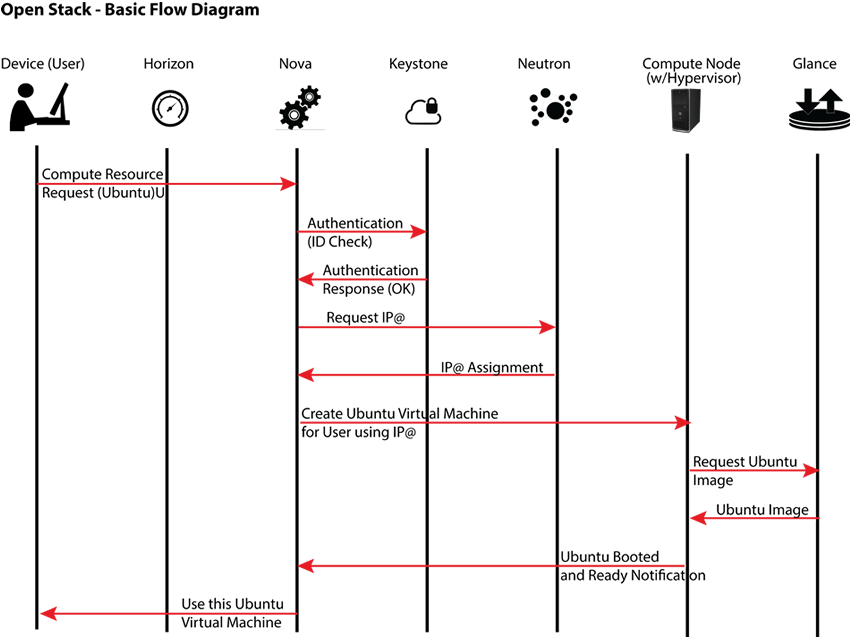
In the future, if new networking services or functionality is required to be added, the network settings can be updated in Neutron and an image can be updated with the new prescribed services using Glance. Next time a cloud resource request is sent from a user, all the new functionality will be instantiated and available in the virtual machine tenant without the user needing to add or update software on the user’s device.
CORD Software – Basic Building Blocks
If the cloud model of OpenStack is translated to the CORD implementation, the user device becomes the customer premise equipment, an aggregation open appliance, or perhaps one of the spine or leaf switches within the CORD architecture. Any of these devices will require operational services and this all can be instantiated on demand in the “CORD cloud” using the OpenStack framework, such that virtualized instances are created in a tenancy arrangement. Therefore, it can be said that these instances of the network nodes are disaggregated from the underlying hardware.
In the diagram “Basic R-CORD POD”, a Residential CORD block diagram illustrates how this disaggregation takes place through abstraction of the hardware nodes entirely orchestrated and created from the head node cluster.
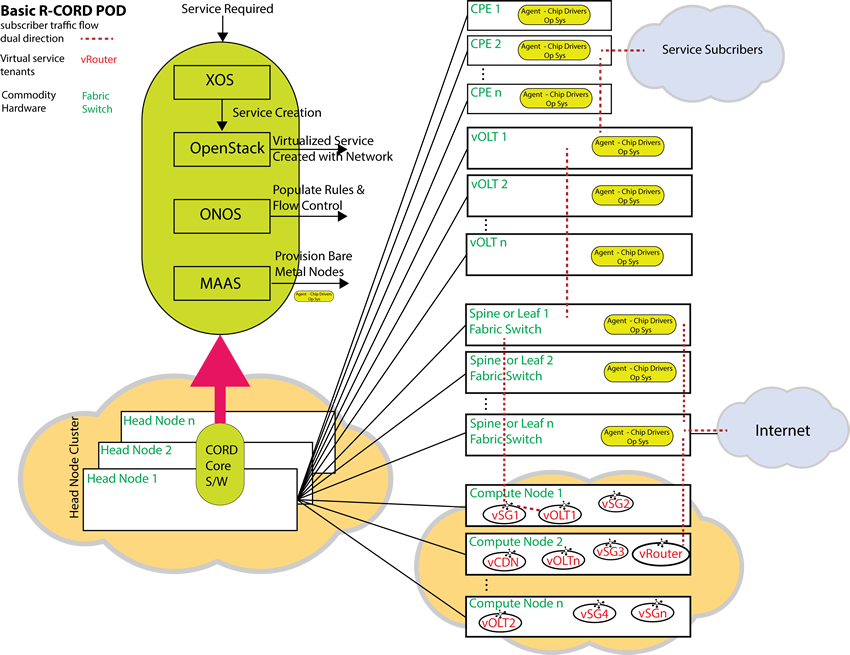
XOS is the Orchestrator for CORD
A CORD service is created through data models input into CORD’s XOS (Everything as a Service). XOS is the orchestrator in the CORD architecture and all the templates for the virtual systems are found within its interface. Not only the virtual instantiations abstracted from the bare metal hardware but also other configuration for the cloud software projects including OpenStack, ONOS and MAAS. As an example, below is a screenshot from the XOS service executing in a “Cord in a Box” simulator that creates a CORD POD within a single server (otherwise known as CIAB). The screenshot shows XOS’s configuration of the images it needs to create the OpenStack installation for the PODs head node deployment. It is a simple example, but everything within the basic CORD POD can be found within XOS’s different templates as the orchestrator for CORD.

Referring back to the diagram “Basic R-CORD POD”, once a service is requested to be created by XOS, OpenStack will work to instantiate that service. For example, this includes virtual service tenants known as vSG, vOLT, vCDN, and vRouter found on the compute nodes. Each of these tenants are created in virtual machines, or in CORD’s case “containers”, on an available compute node. In this way, when a customer requires a new CPE installed at their location, only an open hardware box is needed. Any service, such as DHCP or Firewall, which in a traditional system resides directly on the CPE, is now instantiated within the vSG (virtual Subscriber Gateway) created by the XOS templates and OpenStack on a compute node. The advantage is speed and flexibility. Speed, in that the services can be swiftly instantiated in the CORD POD at the edge office, and flexibility in being able to add or subtract customer services within the edge office virtual tenants as needed. In addition, it is not just the vSG, there is also a vOLT (virtualized OLT instantiation), a vCDN (virtualized content delivery network), and a vRouter that provides the necessary gateway services to the internet, core network, or metro network upstream from the CORD edge office.
ONOS is the SDN Controller for CORD
With XOS and OpenStack, the CORD head node is able to spawn the virtual machines and containers representing the network nodes. Once these are created, ONOS or Open Network Operating System (an open source platform) operates in the form of an SDN controller for CORD using its northbound abstractions and APIs to interact with XOS and OpenStack. Correspondingly, it provides the southbound abstractions and OpenFlow interface to the CORD POD nodes and acts as the overall authority on the control plane for dynamic configuration of data flows. Finally, ONOS works in conjunction with OpenStack’s neutron service to create the virtual networks necessary to interconnect the CORD POD, which ultimately creates a chain of service for a customer.
MAAS Installs the OS on CORD Nodes
Metal as a Service, or MAAS, is an integral part of the CORD head node operations. Its function is to deliver the working software images that the “bare-metal” nodes require to boot up and interact with the CORD OpenStack and ONOS services. In CORD, as discussed earlier, the nodes are all open hardware boxes and some utilize merchant silicon. MAAS works similarly as a PXE server and it serves the images to these open hardware boxes that normally only arrive with a small bootloader installed. Below is a screenshot of the MAAS interface once it is deployed on a head node. Depending on the node architecture, MAAS can select from multiple images suitable for the device and its architecture.
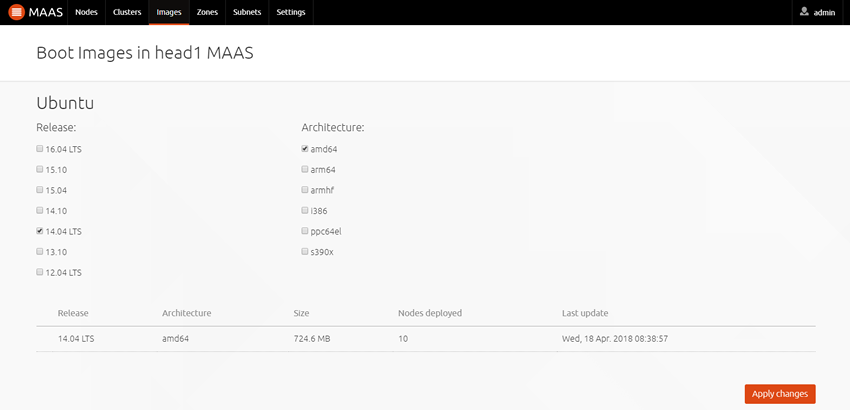
CORD Uses Docker Containers
Earlier it was discussed in the OpenStack description that virtual machines are used to provide the tenancy services. In CORD however, this is not always the case. In many instantiations, for example the vSG or vOLT service tenants, the method to isolate the tenant is not a virtual machine but a concept known as a Linux “container.” CORD uses containerization by means of the Docker container technology. Compared with virtual machines, containers use far less system resources. vSGs representing each individual customer will need hundreds or thousands of instances within a CORD POD. Containers provide just a big enough slice of an operating system, its programs and libraries where the vSG services can execute yet still remain isolated.
Other CORD Architectures
This brief has used Residential CORD as an example. At the moment, OpenCORD defines three different CORD architectures which includes R-CORD. The other two architectures are Mobile CORD or M-CORD and Enterprise CORD or E-CORD. Each of these CORD architectures uses the same principle as with R-CORD in that network services are virtualized (disaggregation) and the same generic hardware platforms are used to houses the service instantiations for the CORD POD services. M-CORD is designed to provide disaggregation of both RAN and CORE components for 4G and upcoming 5G networks. 4G Nodes such as the MME, SG, PG and PCF can all be virtualized using M-CORD. E-CORD on the other hand uses a minimum of two of the same basic CORD PODs to support enterprise customers. The two E-CORD PODs can then be connected either by Layer 2 or Layer 3 VPN. Similar to R-CORD, E-CORD instantiations such as vCPE create QinQ headers for customer data and adds or removes VLAN tags for upstream and downstream data respectively. Some other E-CORD services; vEE (Ethernet Edge) to aggregate traffic, vEG (Enterprise Gateway) provide virtual network functions such as bandwidth functions, firewall and diagnostics, and vRouter to provide upstream connectivity towards the internet. Each of the CORD technologies is a topic unto themselves but operate using the same principles outlined here, and so it is best left to the reader to investigate further.
CORD to Bring Efficiency and Agility
Open CORD is part of the Open Networking Foundation and their stated goal is “to create an open virtualized service delivery platform that provides cloud economies and agility”. Customer equipment, aggregation and core office equipment is simplified into commodity open-hardware equipment and white-box servers where the customer’s data is serviced by virtualized instantiations that are abstracted from the actual hardware of the nodes. Virtualized services and the underlying hardware is all configured, controlled and provisioned from the CORD head node using the OpenStack framework, XOS, ONOS, and MAAS. The head node cluster eventual creates the virtual services arranged as tenants in Docker containers. Those virtualized services then form a chain to service a customer’s data as it traverses the CORD network.
Through applying cloud technology, CORD can radically change the characteristics of residential, mobile and enterprise edge offices by creating a virtualized edge office on top of an OpenStack cloud framework. Further, the CORD POD using the principles of SDN, utilizes the power of ONOS to control data flows across the virtualized network where metering, DHCP, firewall or any number of services can be applied.
It is suggested to refer to the Open Network Foundation umbrella organization and its sub-organizations such as OpenCORD to investigate further into the details of CORD and other software projects including ONOS and XOS. Further information for other software such as MAAS, ONIE and Docker can also be found under their respective organization webpages.








